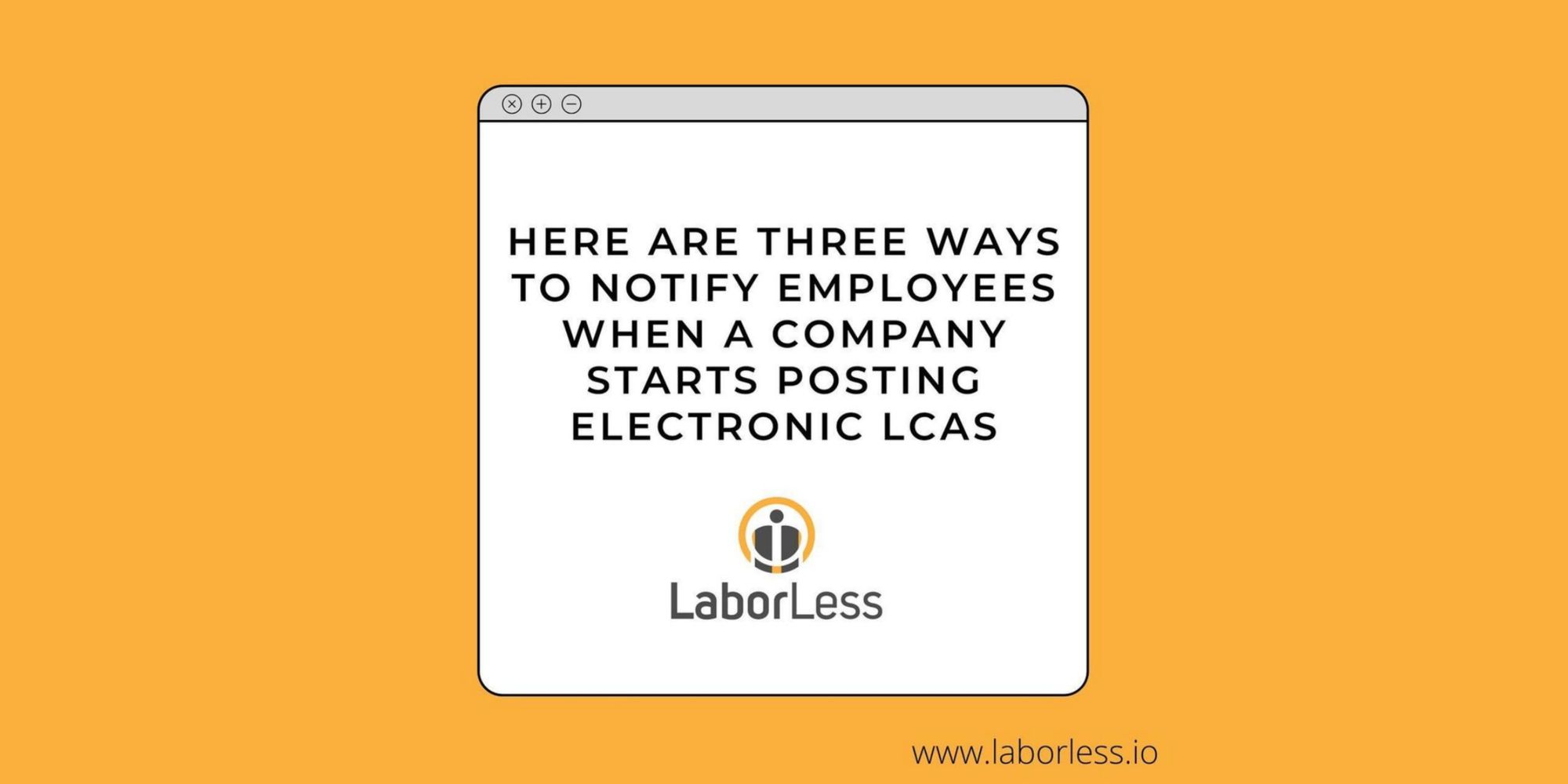The rise in acceptance and popularity of electronic LCA posting has also raised a number of questions, most importantly: what’s the best way to notify affected workers, per 20 CFR § 655.734, when posting an LCA notice electronically?
While the Department of Labor gave us some clues in their March 15, 2019 Field Assistance Bulletin, the FAB couldn’t possibly cover all the ways a company can provide notice for electronic LCA notices. So here are three ways to notify employees when a company moves their LCA postings from physical, paper posting to electronic posting.
The context here, of course, is that a company has agreed to finally move away from printing and posting hard copy LCA notice documents to posting them electronically. For us, this happens when an H-1B employer – or law firm, relocation company or other immigration service provider that's going to post on behalf of their H-1B employer clients) first gets started with LaborLess. One of their first questions is always: now that we're posting electronically, how do we notify our employees (which is required) of this new posting location?
So I always have a few recommendations handy.
Three main ways to provide notice of electronic LCA postings to affected workers.
Here are my three three main ways I recommend providing notice of electronic LCA postings to affected workers.
Add an electronic LCA posting link on the company's external website.
Most companies, on their external website, have a careers page or other forum for sharing information about job openings and related opportunities. In my view, this is the best way to provide notice of electronic LCA postings to workers because it's public-facing, so there's no question that the company's employees have access to it.
To quote the March 15, 2019 FAB,
The affected workers must have knowledge of the electronic resource where the notice is posted. “[A]n employer may accomplish this by any of the means it ordinarily uses to communicate with its workers about job vacancies or promotion opportunities, including through its ‘home page’ or ‘electronic bulletin board’ to employees who have, as a practical matter, direct access to these resources.” 20 C.F.R. 655.734(a)(ii)(B) (emphasis added)
As a practical matter, all employees should be aware of the careers page on their employer’s website, or can be made easily aware of it. Plus, since it’s on the public web, as long as they have an Internet connection, they should have access to it.
This last part is also particularly important when the H-1B employer sends H-1B workers to third party worksites. Because by being on the company's public-facing website, affected workers at the third party worksite can see and have access to the electronic LCA notices as well.
Add an electronic LCA posting link to the employer’s intranet.
Like the first option, by adding a link to electronic LCA notices on an H-1B employer’s intranet (i.e. their internal “Internet”), the employer is providing notice to its employees because, presumably, all employees are aware of and have access to their intranet. It can live on an internal job posting site (many companies post job opportunities internally before doing so on their external website), an internal legal notices page, or wherever else the H-1B employer, and their immigration attorney, see fit.
Of course making sure that it’s in a location that employees, to quote the quote above, “as a practical matter” have access to is important. And note, though, that since this example is internal, this page would NOT be accessible to potential affected employees outside the organization, which means that if the company sends their H-1B workers to third party worksites, this might not be sufficient. Again, this would be a situation for the company to explore with their immigration attorney.
Add an electronic LCA posting link to the company's employee handbook or hang a hard-copy notice.
Every employee gets and should look at an employee handbook, whether they’re just starting a new job or have been on the job for decades. Adding information about electronic LCA compliance in this way could also show that the company provided notice to all its employees.
The same can be done with a hard copy notice that has the electronic LCA posting URL listed on it. This sounds a bit counterintuitive because, wasn’t the point of electronic LCA posting to get away from hard copy posting in the first place?
True, but the DOL listed this as an option on the FAB in the middle of page 4: “Similarly, the H-1B petitioner complies by posting a hard copy message in a conspicuous site or directing affected workers to the website where the notice is posted for that particular worksite. In this situation, the H-1B petitioner has complied with its obligation to notify.”
In other words, a real-life “redirect” notice that hangs where LCA notices used to hang, or somewhere else deemed appropriate by the company and their immigration attorney, that effectively says, “Hey! If you want to see LCA notices, visit this URL:...”
LaborLess is the best way to post electronic LCAs and create and manage electronic public access files.
Ultimately, figuring out the best way to provide notice to affected workers is something we work through with all of our clients at LaborLess. Since we’re not their attorneys, we can’t advise them exactly on what to do, but we’ll often work with an employer’s in-house immigration and/or their outside immigration law firm, give our recommendations based on their existing processes, and support them as they figure out the best way to leave paper LCA posting and PAFs behind and automate and streamline the process moving forward.
If you’d like to learn more about how LaborLess can help you get started with electronic LCA posting and public access files, check us out!
And if you’re already doing some version of it through a “home made” LCA posting site and creating and storing digital PAFs manually, you’re way ahead of most H-1B employers and immigration law firms. Let LaborLess help you take that process to the next level.
Have questions? Reach out to us to learn more!

